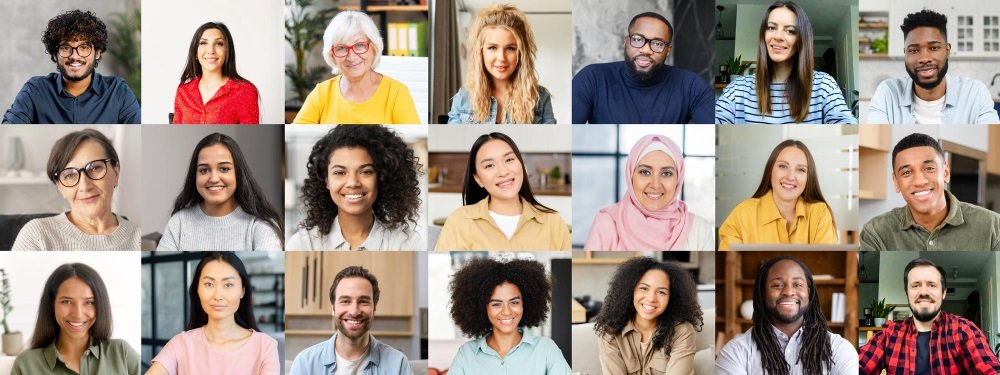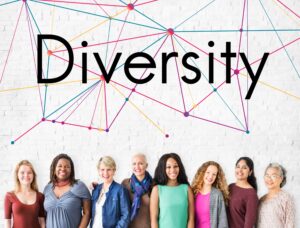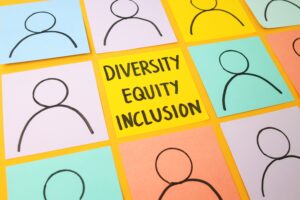
Workplace diversity isn’t just a box to tick on a company policy—it’s about people. It’s about the mix of stories, skills, and perspectives that employees bring with them, and how organizations create space for those voices to be heard. When individuals from different cultures, ages, genders, religions, and abilities feel valued, the benefits go far beyond numbers. Teams become more creative, collaboration strengthens, and company culture grows healthier.
But there’s a difference between diversity and true inclusion. Diversity is about representation—having different people in the room. Inclusion is about belonging—making sure everyone feels respected, supported, and given equal chances to grow. Fair pay, career opportunities, and safe workplaces all play a role in making that possible.
Here in Cyprus, where workplaces are becoming increasingly multicultural, these conversations carry even greater weight. In this post, we’ll explore what diversity really means, why DEI matters for organizations, the main types of workplace diversity, and how surveys can help employers understand and improve inclusivity.
What is diversity in the workplace?
Diversity in the workplace refers to the presence of employees with a wide range of characteristics, backgrounds, and perspectives within an organization. This includes—but is not limited to—differences in race, ethnicity, gender, age, religion, sexual orientation, physical abilities, socioeconomic backgrounds, education, and worldviews.
A truly diverse workplace is not just about representation; it also values and leverages these differences so that every employee can fully contribute their unique experiences and ideas, leading to greater creativity, stronger collaboration, and more innovative problem-solving.
Diversity helps organizations reflect the broader community, enhances business performance, and fosters an environment where everyone feels respected and included.
What is the purpose of diversity in the workplace?
The purpose of diversity in the workplace is to bring together individuals with a wide range of experiences, perspectives, and backgrounds to drive stronger business outcomes and create a more inclusive culture.
By fostering diversity, organizations benefit in several ways:
- Boosts creativity and innovation: Varied perspectives encourage fresh ideas, creative solutions, and better problem-solving.
- Improves decision-making: Diverse teams make smarter, more well-rounded decisions and are less prone to groupthink.
- Expands the talent pool: Welcoming diversity attracts top candidates and cultivates a richer set of skills across the organization.
- Increases employee engagement and morale: Employees who feel included and valued are more satisfied, engaged, and likely to remain with the company.
- Drives better business performance: Research consistently links higher diversity with increased productivity, profitability, and a stronger brand reputation.
Additionally, diversity in the workplace is about creating an environment where every employee feels they belong, can thrive, and contribute to the company’s long-term success.
Why is diversity important in the Workplace in Cyprus?
Diversity is important in the workplace in Cyprus because of the island’s unique multicultural context and its connections to global business markets. As Cypriot companies employ people from a variety of cultural, ethnic, and social backgrounds—including both local Cypriots and international talent—embracing diversity helps organizations understand and serve a wider range of customers, foster innovation, and remain competitive in the modern economy.
A diverse workplace encourages the exchange of different ideas and viewpoints, leading to better teamwork, higher morale, and greater problem-solving abilities. Studies highlight that companies in Cyprus with diverse leadership and teams often experience higher employee engagement, better retention, and stronger business performance compared to less diverse organizations.
Additionally, as Cyprus adapts to European and international standards for diversity, equity, and inclusion, prioritizing diversity is not just a matter of social responsibility—it’s a strategic advantage for business growth, employee satisfaction, and long-term success.
What are the benefits of having diversity in your workplace?
Having diversity in your workplace brings a wide range of benefits, including:
- Greater creativity and innovation: Teams with diverse backgrounds, experiences, and perspectives generate more original ideas and creative solutions to problems, which drives overall innovation.
- Better decision-making: Diverse groups make smarter, more effective decisions by considering a variety of viewpoints and avoiding groupthink; studies show they outperform non-diverse teams in problem-solving up to 87% of the time.
- Higher employee engagement and morale: Inclusive environments where people feel valued and respected lead to increased job satisfaction, greater loyalty, and reduced turnover rates.
- Improved company performance: Companies with greater diversity are more profitable, more likely to outperform industry competitors, and perform better financially—research links higher diversity with increased productivity and innovation revenue.
- Access to wider talent pools: Embracing diversity enables organizations to attract top candidates from more backgrounds, strengthening teams and improving recruiting outcomes.
- Better brand reputation: Diverse companies are perceived as more relatable, socially responsible, and appealing to customers, partners, and new markets, thus building a strong employer and business brand.
- Reduced bias and increased fairness: A culture of diversity actively helps reduce biases and discrimination, leading to fairer pay, promotion, and workplace practices.
These advantages add up to a workplace that not only values its people but also achieves measurable business results through its commitment to diversity and inclusion.
What is the impact of diversity in the workplace?
The impact of diversity in the workplace reaches every level of an organization. When people from a wide range of backgrounds, cultures, and life experiences come together, they introduce new perspectives that challenge conventional thinking and spark fresh solutions. This not only fuels creativity and problem-solving but also drives long-term business success by making companies more adaptable and innovative.
Embracing diversity also transforms workplace culture. Employees who feel respected and valued for their unique contributions are more likely to be productive, highly engaged, and dedicated to their work. This sense of belonging doesn’t just make people happier—it strengthens their connection to the company’s mission and helps retain top talent for the future.
What is diversity, equity and inclusion (DEI) in the workplace?
Diversity, equity, and inclusion (DEI) in the workplace refers to an active commitment to welcoming and valuing people from a wide range of backgrounds, ensuring that everyone is treated fairly, has access to opportunities, and feels genuinely included in the organization.
- Diversity means having a mix of people with different identities, experiences, and perspectives—such as variations in race, gender, age, ability, religion, socioeconomic status, and more.
- Equity is about providing fair treatment by recognizing that not everyone starts from the same place, and removing barriers so that all employees have the support they need to succeed.
- Inclusion ensures that every employee feels welcomed, respected, and able to fully participate, fostering a true sense of belonging and giving everyone a voice.
Together, DEI creates a workplace culture where differences are valued, barriers are broken down, and all employees are empowered to contribute and thrive.
What is a workplace diversity, equity and inclusion survey?
A workplace diversity, equity, and inclusion (DEI) survey is a tool organizations use to gather honest feedback from employees about their experiences and perceptions related to diversity, fair treatment, and inclusiveness at work. These surveys typically ask questions about how valued and respected people feel, whether opportunities are equal for everyone, and whether employees see the culture as welcoming for all backgrounds and identities.
The purpose of a DEI survey is to uncover both strengths and challenges in a company’s culture, helping leaders identify hidden barriers, areas for improvement, and employee concerns that might not be obvious. Data from these surveys is used to drive meaningful change, such as updating policies, improving training, and shaping new DEI initiatives—ultimately building a more fair and supportive environment for everyone.
How does a workplace diversity, equity, and inclusion survey work?
A workplace diversity, equity, and inclusion (DEI) survey typically works by gathering confidential feedback from employees through a well-structured set of questions about their experiences, perceptions, and feelings related to diversity, fairness, and inclusion at work.
Here’s how the process usually works:
- Designing the survey: The organization creates a survey with questions on topics like belonging, representation, fairness, respect, and accessibility. Questions might be multiple-choice, use rating scales, or allow for open-ended comments.
- Collecting responses: The survey is distributed—most often online and anonymously—so employees feel comfortable sharing honest feedback without fear of reprisal.
- Analyzing the results: Once responses are collected, the data is examined to identify patterns, track representation and inclusion, and highlight any disparities or areas needing attention.
- Taking action: Results inform leadership decisions, help set priorities, and guide new initiatives or policy changes to make the workplace more welcoming and equitable. Follow-up surveys track progress over time.
By giving every employee a voice and using confidential data, DEI surveys help organizations spot barriers, build trust, and create an environment where everyone can thrive.
What is cultural diversity in the workplaces of Cyprus?
Cultural diversity in the workplaces of Cyprus refers to the presence and appreciation of employees from a range of cultural, ethnic, national, and linguistic backgrounds—including both local Cypriots and individuals from across Europe, Asia, Africa, and beyond. This diversity is reflected in the blend of customs, traditions, languages, and viewpoints represented within teams, which can make Cypriot workplaces more dynamic and innovative.
Promoting cultural diversity in Cyprus means not only recognizing these differences but also creating an environment where everyone feels respected and valued for their unique contributions—whether that’s through celebrating various cultural holidays, supporting multiple languages, or making space for different customs and ideas in the workplace.
This approach helps build a more inclusive, supportive, and vibrant work environment, fostering better communication and stronger business results in a country that serves as a crossroads of regional and global influences.
How is diversity in the workplace categorised in Cyprus?
Diversity in workplaces in Cyprus is vibrant, just like its history and culture. It includes various ethnicities and nationalities, along with differences in gender and age. The work environment shows a mix of experiences. Recognising racial diversity, disability diversity, and sexual orientation diversity is also essential to building a truly inclusive workplace.
The laws in Cyprus show a better understanding of these needs. However, it is still important to focus on applying these laws and creating a culture of respect and understanding. Many companies in Cyprus are now adopting DEI initiatives. They want to create workplaces where everyone feels accepted and valued.
1. Cultural Diversity in the Workplace
Cultural diversity in the workplace is more than just noticing people from different backgrounds. It’s about making a place where everyone feels valued and respected. This means understanding and appreciating various cultures, traditions, and viewpoints. It can make the workplace lively with new ideas and different ways of thinking. One way to support cultural diversity is to celebrate religious holidays from various cultures.
It is also important to create a welcoming space where people can show their cultural identity. This could be through their clothing, language, or customs, as long as it respects everyone else’s well-being. Organisations can create a better and more welcoming atmosphere when they are sensitive to cultural differences. This results in improved communication, greater understanding among coworkers, and a more respectful and lively workplace culture.
2. Gender diversity in the workplace
Gender diversity is crucial for a successful workplace. It means ensuring everyone, regardless of gender, has the same chances. This includes fair hiring, equal pay for equal work, and access to growth opportunities. One important part of gender diversity is having more women in all types of roles within a company, especially in leadership positions.
When more women lead, it not only supports equality but also brings fresh perspectives and different ideas for decision-making. It is also important to tackle unconscious bias in performance reviews and promotions. We need to remove barriers that prevent people from succeeding. Creating a workplace where everyone can achieve their best, regardless of gender, is vital for being inclusive and prosperous.
3. Age Diversity in the Workplace
Age diversity in the workplace is essential. It shows how valuable people of all ages are. Baby boomers bring much experience, while younger employees offer fresh ideas and are good with technology. Each group has its skills and viewpoints.
Companies can significantly benefit from teamwork between different age groups. Companies can gain helpful insights and new ideas by creating chances for older and younger workers to mentor each other and share knowledge.
This also helps reduce generational gaps and leads to a friendlier work environment. Furthermore, companies should have training programs designed for various age groups. This way, everyone can keep learning, improving, and staying up-to-date in the fast-changing work environment.
4. Racial Diversity in the Workplace
Racial diversity in the workplace means accepting and appreciating the unique skills of people from different races and ethnic groups. It is not just about noticing skin colour; it also celebrates the wide range of experiences, viewpoints, and backgrounds that everyone offers.
To build a genuinely inclusive workplace, organisations must fight against racism and discrimination in every form. They should set strict anti-discrimination rules, provide training on diversity and inclusion to all workers, and create an environment that values respect and understanding.
Additionally, companies should focus on outreach and recruitment efforts to mirror the racial diversity of their communities in their teams. It is key for the hiring process to be fair and equal for all candidates.
5. Disability Diversity in the Workplace
Disability diversity means that people with disabilities are important to the workforce. It focuses on building an inclusive workplace where people with disabilities should feel supported, respected, and valued for what they can do. It also involves making adjustments so they can fully participate in their jobs.
Companies should work on making workspaces accessible for everyone. This does not only mean installing ramps and accessible restrooms. It also includes providing tools that help, changing workspaces, and allowing flexible schedules to fit individual needs.
It’s also very important to change any stereotypes about disabilities. We need to teach employees about how to treat others with disabilities well. Encouraging open communication and celebrating the achievements of workers with disabilities are key steps to creating a truly inclusive workplace.
6. Sexual Orientation Diversity in the Workplace
Sexual orientation diversity means that a person’s sexual orientation is a key part of who they are. This should be respected in the workplace. Everyone should have the same rights and chances, no matter who they love or are attracted to.
Creating a safe and inclusive workplace for LGBTQ+ people is not just about following laws. It’s a matter of human rights. We need a culture where workers can feel safe being open about their sexual orientation. They should not fear discrimination or judgment.
Organisations must have strong rules to protect LGBTQ+ workers from harassment. They should also provide diversity and inclusion training focusing on LGBTQ+ issues. Building a welcoming and supportive environment for all employees matters. This is the way to create a fair and equal workplace for everyone.
How can you improve diversity and inclusion in the workplace?
Improving diversity and inclusion in the workplace starts with creating an environment where everyone feels they belong and has equal access to opportunities.
Here are some practical methods organizations can use to improve diversity and inclusion:
- Foster a sense of belonging: Make sure employees feel connected, valued, and respected through open communication and inclusive team cultures.
- Ensure fairness and equal growth: Review compensation, promotions, and development opportunities to eliminate bias and provide equal chances for advancement.
- Educate and train: Deliver regular diversity, equity, and inclusion training that addresses unconscious bias and encourages inclusive behaviors at all levels of the organization.
- Attract diverse talent: Use inclusive language in job postings, expand outreach to underrepresented groups, and adopt fair, skills-based recruitment processes.
- Promote at all levels: Diversity and inclusion should be modeled by leaders and woven into every part of the organization—not just entry or mid-level roles.
- Listen and take action: Gather employee feedback via surveys and discussions, then act on suggestions to continuously improve policies and the workplace environment.
- Celebrate and recognize differences: Mark cultural, religious, and awareness days, and encourage dialogue about diverse backgrounds and experiences.
Real, lasting progress is achieved through daily practice, leadership accountability, and a genuine commitment to supporting every employee’s success.
How can cultural diversity in the workplace be managed?
Managing cultural diversity in the workplace means going beyond acknowledging differences—it’s about actively building an inclusive environment where every individual feels respected, valued, and empowered to contribute. Cultural competence training is essential, helping team members understand each other’s backgrounds, foster empathy, and communicate effectively.
Organizations should create spaces that encourage employees to openly share their experiences and cultural traditions—such as hosting interactive cultural events, workshops, and lunch-and-learn sessions—which help teams connect on a deeper level and celebrate diversity together. Policies that challenge unconscious bias and promote fair decision-making are critical; support a culture where critical thinking is encouraged and hidden biases are addressed head-on through open discussions and structured feedback.
Above all, fostering a culture of empathy and mutual respect unlocks the full potential of a diverse workforce, driving innovation and creating a positive, collaborative, and productive workplace for everyone.
What are some examples of diversity in the workplace?
True workplace diversity goes far beyond surface-level categories—it’s about recognizing and celebrating the full range of human experiences and perspectives within a team. When organizations embrace diversity holistically, they strengthen creativity, problem-solving, and overall workplace culture.
Here are a few examples illustrating how different perspectives can enrich the tapestry of the workplace:
| Category | Examples |
| Age | Having employees from different generations, such as Baby Boomers, Gen X, Millennials, and Gen Z. |
| Cultural | Representation from different nationalities, ethnicities, religions, and languages. |
| Disability | Individuals with visible and invisible disabilities, including physical, sensory, and cognitive differences. |
| Gender Identity | Employees who identify as male, female, transgender, non-binary, and other gender identities. |
Organisations can unlock the true power of diversity by embracing people from different backgrounds, promoting inclusive policies, and fostering a workplace culture of respect and understanding.
What action should you take next?
Building a diverse and inclusive workplace takes more than good intentions—it requires real action. Start by evaluating your company culture and identifying ways to make everyone feel valued and included.
Make diversity a priority in your hiring process by giving all qualified candidates an equal chance, no matter their background. But inclusion doesn’t stop at recruitment. Foster open communication, encourage different perspectives, and create an environment where everyone feels heard and respected.
Leaders set the tone, so lead by example. Commit to diversity and inclusion through your decisions and daily actions. A workplace that embraces diversity isn’t just the right thing to do—it’s a powerful advantage in today’s global world.
Now is the time to act. Start creating a workplace where everyone belongs!
Turn Your Workplace into a Great Place to Work!
Employees thrive in great company cultures—let’s build yours! Whether you’re aiming for higher engagement, better retention, or Great Place to Work certification, we’re here to help. Fill out the form and let’s talk!
Latest Articles

5 Key Benefits of Diversity for Cypriot Workplaces and Their Employees

7 Reasons Why Diversity is Important in the Cypriot Workplaces

14 Employee Engagement Activities for Workplaces in Cyprus

Diversity, Equity, and Inclusion: A Guide for Cypriot Workplaces

4 Effective Methods to Improve Workplace Culture in Cyprus

